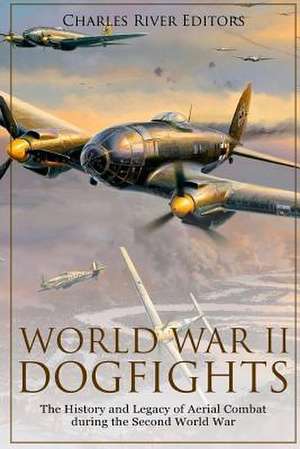World War II Dogfights
Autor Charles River Editorsen Limba Engleză Paperback
*Includes accounts of the fighting
*Includes online resources and a bibliography for further reading
Like lethal insects undergoing a series of metamorphoses into ever more mature and dangerous forms, military aircraft moved rapidly from stage to stage of their development as the 20th century progressed. The catalyst of war provided the swiftest impetus to this evolution. The new mechanized armies existing from the later period of World War I onward seized on the fresh technology and sought to squeeze every possible drop of advantage from it that the limits of science and the era's materials would allow.
Many military thinkers and even aeronautical enthusiasts believed that blimps would remain the chief military aerial asset more or less forever. These men thought airplanes would play a secondary role at best, and might even prove a uselessly expensive gimmick soon to fade back into obscurity, leaving the majestic bulk of the dirigible as sole master of the skies. Thus, when World War I began, airplane improvements occurred in an ad hoc, almost accidental manner during the war. However, when pilots' mounting of armaments on airplanes proved a successful means of defeating other aircraft and even attacking men on the ground, a much more active and systematic development of warplanes began across the continent. Each advance prompted a countermeasure, as the two sides strove for primacy in a deadly, unforgiving environment which rewarded real advances in equipment and tactics with survival and punished poor ideas with death. Before long, relatively powerful, heavily armed aircraft buzzed through the skies over battle-stained Europe, tearing each other apart with furious gusts of machine gun fire and sending many of the vaunted dirigibles plunging, burning, to the ground. The new era of fighting aircraft arrived in dramatic fashion, raising successful pilots to celebrity or heroic status, and laying the groundwork for the tremendous potential of airpower to achieve its next logical expansion in World War II and beyond.
By the time World War II arrived, the fighter airplane appeared as a much different beast than the purpose-built aircraft-hunting machines of 1917 and 1918. Though propellers still provided motive force, greatly increased engine power allowed these aircraft to slice through the sky at speeds of 200 mph, 300 mph, or even in excess of 400 mph when flying flat-out. Service ceilings jumped to 25,000 feet, 30,000 feet, or higher, altitudes unthinkable to World War I's aviators. Engineering and research and development began working scientifically to shave time off the climb rate and address a host of other problems and possibilities.
At the start of the war, as the German Luftwaffe first flew against Poland and then the Royal Air Force, aircraft were already swift, metal-skinned hunter-killers in the sky, with enclosed cockpits, armor, and powerful loadouts of machine guns, 20mm cannons, and, soon, rockets. But an even bigger transformation awaited - the birth of the jet age, a future glimpsed briefly in the spectacular but doomed appearance of the Messerschmitt Me 262 near the war's end.
World War II Dogfights: The History and Legacy of Aerial Combat during the Second World War looks at how technology and tactics evolved during the war. Along with pictures of important people, places, and events, you will learn about World War II dogfights like never before.
| Toate formatele și edițiile | Preț | Express |
|---|---|---|
| Paperback (2) | 65.03 lei 6-8 săpt. | |
| – | 65.03 lei 6-8 săpt. | |
| – | 77.60 lei 6-8 săpt. |
Preț: 65.03 lei
Nou
Puncte Express: 98
Preț estimativ în valută:
12.44€ • 12.99$ • 10.30£
12.44€ • 12.99$ • 10.30£
Carte tipărită la comandă
Livrare economică 04-18 aprilie
Preluare comenzi: 021 569.72.76
Specificații
ISBN-13: 9781981836567
ISBN-10: 198183656X
Pagini: 60
Dimensiuni: 152 x 229 x 3 mm
Greutate: 0.1 kg
ISBN-10: 198183656X
Pagini: 60
Dimensiuni: 152 x 229 x 3 mm
Greutate: 0.1 kg
